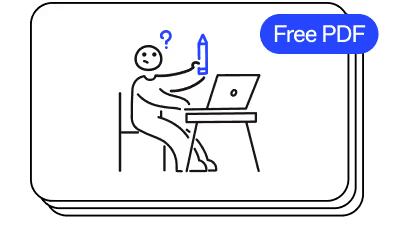How internal mobility unlocks employees’ potential

Give HR and managers the clarity, confidence, and connection to lead better every day.

Today’s employees want clear career paths and the chance to grow. When those opportunities aren’t there, you risk losing your best people. Focusing on internal mobility gives you the chance to boost engagement while building a workplace where employees want to stick around.
In this guide, we discuss what internal mobility means, why it’s so important, and offer tips to improve your approach.
What does internal mobility mean?
Internal mobility refers to when an employee moves into a new role within the same organization. This could be a promotion or a lateral move to a position at the same level. Establishing internal mobility programs allows companies to tap into employees’ potential and underutilized skill sets.
For example, say a company is looking to hire a new marketing coordinator. HR could spend months interviewing external candidates, but a current marketing colleague may already have the prerequisite skills for the job. Promoting this person would avoid recruitment costs. Plus, their existing familiarity with company systems would make for a much smoother onboarding process.
Internal mobility programs help HR teams broadcast open roles internally and even proactively check if anyone within the organization has the right skills and qualifications.
Why is internal mobility important?
Recent Deloitte research found that 73% of executives think that businesses should do more to help their workforce build on-the-job experience, and 72% of workers agreed with them. Internal mobility processes facilitate this while priming employees for promotions or lateral moves.
These programs also improve employee experience while boosting company profitability. LinkedIn’s Workplace Learning Report states that at the two-year mark, the likelihood of an employee staying with a company is 75% if they make an internal move, and just 56% if they don’t. Internal mobility opportunities give employees a way to stick around while furthering their career or find a position more to their liking. Turnover is costly, so anything that retains workers is a worthwhile endeavor.
Internal mobility also drives adaptability. According to LinkedIn, organizations that prioritize career development are more likely to be ready for AI adoption. The same report found that these companies are more likely to be profitable, attract quality talent, and retain employees.
Benefits of internal mobility
Here’s how an effective internal mobility strategy results in better business outcomes.
Faster, smarter hiring
The hiring process can get expensive. Research from the Work Institute states that replacing an employee costs roughly 33% of their base pay. Internal mobility mitigates some of this financial impact by significantly lowering recruitment costs.
Filling a role internally is also far more efficient than hiring externally. Since current employees already know the company’s processes, onboarding is a much smoother process. Teams are likely already familiar with the internal hire, too, softening the process of establishing a new work rhythm.
Boosted employee loyalty
When employees don’t see a future at a company, there’s not much to keep them sticking around. Offering advancement opportunities through internal mobility programs shows that management respects their skills. This builds trust that the company will support them as they pursue their career goals.
Skill sets aligned with business needs
In reality, not everyone is perfectly suited to their current role. Internal mobility programs help identify diverse skill sets and match them to business needs. Moving talent into better-suited positions also makes for a happier workforce and more productive teams.
Agility in a changing market
In these technology-driven times, industries shift on a dime. Companies must keep up if they want to stay competitive. When employees step into other roles within the business, they bring their previous skill set with them. Sharing knowledge between teams in this way results in a more agile workforce that’s better fixed to adapt to change.
A better employee experience
When someone is stuck in the same role for a long time, they might feel they’re stagnating. Career development pathways, both for promotions and lateral moves, help employees feel supported instead of stale. The prospect of moving into a more senior role can also be a strong motivator for upskilling and exceptional performance.
5 types of internal mobility
Here are the five key types of internal mobility.
1. Vertical mobility
Vertical mobility is when employees earn a promotion and move into a higher-level role. Examples include moving to a management position, as well as departmental promotions, like advancing from account executive to account manager.
2. Lateral mobility
Lateral mobility refers to employees transferring to different roles at the same level, such as in a different department. For example, a marketing specialist might move to the business development team. Such moves allow colleagues to explore new career paths and are a great way to increase employee engagement, especially when upward moves aren’t possible.
3. Project-based mobility
Employees may occasionally be assigned a temporary role outside of their regular responsibilities. These project-specific task forces are a great opportunity for knowledge sharing and skills development. They also build cross-team relationships and a sense of camaraderie.
4. Geographic mobility
Employees might want or need to relocate to a different city or country. Geographic mobility facilitates this process. It’s also useful if a business has a talent gap in one location and extra capacity in another. In this scenario, it’s not uncommon for companies to offer incentives to encourage employees to relocate.
5. Role expansions
Role expansions are when employees take on more tasks and responsibilities, but their job title doesn’t usually change. It’s a way to make use of any extra capacity, encourage career growth, and even prepare them for a leadership position.
How to improve your internal mobility strategy
Internal mobility strategies inform employees that their careers are taken seriously. Here are five ways to refine your approach.
1. Make internal opportunities visible
Make every open role visible to internal teams first, before posting it externally. Publish positions somewhere everyone in the organization can find them, like an internal job board. This makes these roles easier to fill internally.
2. Train managers as mobility champions
Ensure managers discuss career growth opportunities in one-on-ones with their reports. Encourage them to support anyone who wants to explore lateral or upward moves. When employees know their manager is in their corner, they’ll more confidently pursue an internal move.
3. Offer skill development and upskilling programs
When team members build in-demand skills, they can move into new roles faster. A higher-skilled workforce is also just good business: Data from Gallup suggests that organizations that invest in employee development report 11% greater overall profitability. Offer upskilling programs tied to business needs and employees’ potential career paths.
4. Use technology to your advantage
Job boards analyze candidates’ resumes to match them with relevant positions, so why can’t you do something similar? Ask employees to map out their existing skills, such as on a company intranet, and use automated tools to match open roles to internal candidates.
5. Drive improvement with feedback
Ask for employee feedback on internal mobility strategies and act on it. Use pulse surveys or focus groups to find out what’s working and what’s not. Demonstrating that feedback results in change shows employees that the company values their development and career trajectories.
Examples of internal mobility in action
To better demonstrate how internal mobility drives results, we’ve drafted the following fictional examples.
“Solar Tech”
In response to a competitive job market, the HR team at Solar Tech launched a structured internal mobility program. Seeing the company encourage upward progression, workers were inspired to try for promotion, rather than seeking opportunities elsewhere. Employee retention jumped 15%, and the average time it took to fill critical roles shrank from eight weeks to five.
Solar Tech’s managers praised the new internal hires for hitting the ground running, boosting morale. Trialling career paths internally turned out to be a smarter talent play than chasing external hires.
“Energy Communications”
Energy Communications decided to introduce cross-functional career rotations to allow workers to try out different roles within their organization. They coupled this initiative with career development coaching. When given the chance to find a role better suited to their skills and interests, their workforce’s enthusiasm soared. Employee engagement reached +20 points on quarterly surveys, and the company saw a 30% uptick in internal applications.
Encourage career growth with Workleap
Give people the opportunity to grow internally, and you won’t just retain talent, you’ll unlock it.
Workleap has the tools you need to support internal mobility. Workleap Officevibe allows you to spot sentiment around career development, collect employee feedback, and track engagement. When combined with the AI-powered insights of Workleap Performance, career conversations stop being vague and start being specific and actionable.
Demo Workleap today to explore how these tools can revolutionize your internal hiring processes.
Addressing poor performance template


%20(1).avif)


.avif)
.avif)







